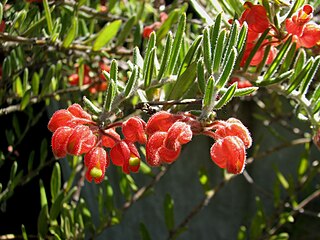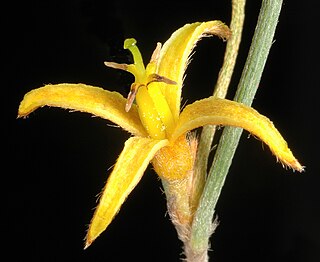
Flora Australiensis: a description of the plants of the Australian Territory, more commonly referred to as Flora Australiensis, and also known by its standard abbreviation Fl. Austral., is a seven-volume flora of Australia published between 1863 and 1878 by George Bentham, with the assistance of Ferdinand von Mueller. It was one of the famous Kew series of colonial floras, and the first flora of any large continental area that had ever been finished. In total the flora included descriptions of 8125 species.

Banksia sessilis var. cordata is a variety of Banksia sessilis, with unusually large leaves and flower heads. It is a rare variety that is restricted to the extreme south-west corner of Western Australia.
Grevillea acuaria is a shrub which is endemic to the south of Western Australia.

Adenanthos sect. Eurylaema is a taxonomic section of the flowering plant genus Adenanthos (Proteaceae). It comprises four species, all of which are endemic to southwest Western Australia.
George Bentham's taxonomic arrangement of Adenanthos was the first comprehensive taxonomic arrangement of that plant genus. It was published in 1870 in his landmark flora of Australia, Flora Australiensis. It would stand for over a hundred years before being superseded by the 1978 arrangement of Ernest Charles Nelson.

Adenanthos sect. Adenanthos is a taxonomic section of the flowering plant genus Adenanthos (Proteaceae). It comprises 29 species. The centre of diversity is southwest Western Australia, with two species extending into South Australia and western Victoria.
Adenanthos filifolius is a species of erect shrub endemic to southwest Western Australia. It was first described by George Bentham in 1870.

Persoonia falcata, commonly known as the wild pear, is a shrub native to northern Australia.

Grevillea saccata, commonly known as pouched grevillea, is a shrub which is endemic to the south-west region of Western Australia. It grows to between 0.25 and 0.5 metres in height. The red flowers usually appear from June to November in the species' native range. The species was formally described in 1870 by English botanist George Bentham in his Flora Australiensis.

Haemodorum is a genus of herbs in the family Haemodoraceae, first described as a genus in 1798 by James Edward Smiith. The genus is native to New Guinea and Australia. The type species is Haemodorum corymbosum Vahl, first described by Martin Vahl in 1805.

Allocasuarina decussata, commonly known as karri oak or karri she-oak, is a medium-sized tree, or more rarely a shrub, that is endemic to the south west of Western Australia. It is an understory tree in karri forest but also occurs as a stunted shrub in places like Bluff Knoll in the Stirling Range.

Haemodorum brevicaule is a perennial herb from 0.025 to 0.3 m tall, in the bloodroot family, the Haemodoraceae, native to northern Australia. It has deep-red to purplish-black flowers which are seen from September to December, and it grows on red clay and basalt.

Haemodorum discolor is a shrub native to southwestern Australia.
Haemodorum ensifolium is a shrub native to northwestern Australia.

Persoonia angustiflora is a species of flowering plant in the family Proteaceae and is endemic to the south-west of Western Australia. It is an erect shrub with hairy branches and leaves, linear, more or less cylindrical leaves and yellow or greenish yellow flowers arranged singly or in groups of up to four.

Isopogon buxifolius is a species of plant in the family Proteaceae and is endemic to the south-west of Western Australia. It is an upright shrub with egg-shaped to elliptic or oblong leaves and clustered spikes of pink flowers.

Isopogon drummondii is a small shrub of the family Proteaceae and is endemic to the southwest of Western Australia. It was first formally described in 1843 by Henri Antoine Jacques in Annales de Flore et de Pomone from an unpublished description by Hügel.

Prasophyllum cyphochilum, commonly known as the pouched leek orchid, is a species of orchid endemic to the south-west of Western Australia. It is a relatively common orchid with a single smooth, tubular leaf and up to thirty or more pale yellow and brown flowers. The flowers do not open fully, are more or less cup-shaped and have a "humped" labellum.
Terry Desmond Macfarlane is a botanist and taxonomist, who has worked in both Australia and Peru. A senior research scientist at the Western Australian Herbarium, Macfarlane is associate editor of its journal Nuytsia and currently collaborates with researchers across Australia and in Canada, Germany, New Zealand, Russia, Spain and United Kingdom. He was also involved in the development of FloraBase, the Western Australian flora database.

Haemodorum spicatum is a plant in the Haemodoraceae family native to south Western Australia.















